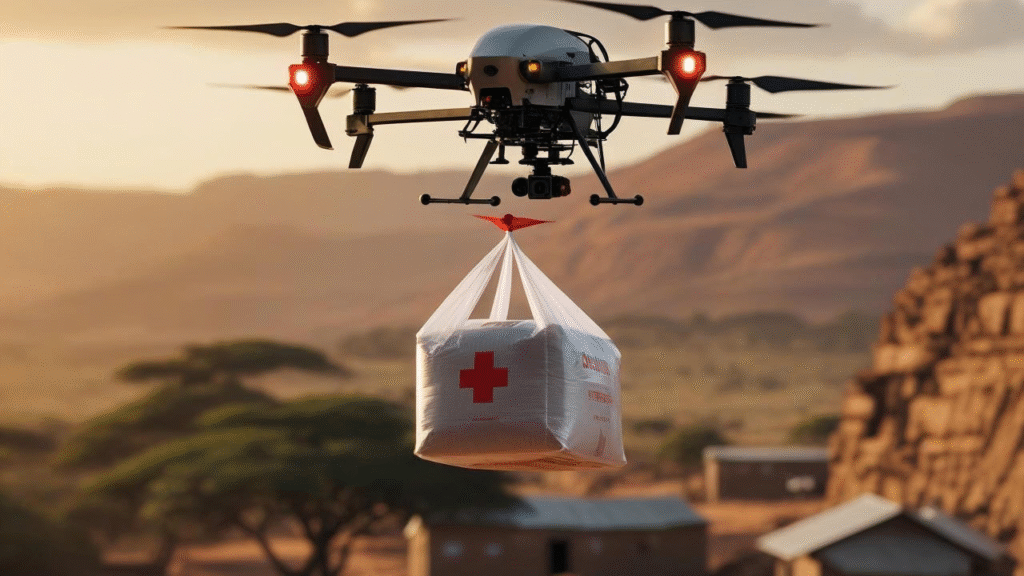Drone delivery systems in East Africa had transitioned from early trials to operational deployment, particularly in the fields of healthcare logistics, rural access, and emergency response. Countries like Rwanda, Kenya, Uganda, and Tanzania were at the forefront, leveraging drone technology to overcome infrastructural gaps and improve access to essential goods. Backed by partnerships with companies such as Zipline, Wingcopter, and regional startups, East Africa became a global case study in the practical application of unmanned aerial systems (UAS) for public good.
Key Players and Projects in East Africa

- Zipline
- Zipline remained the most prominent drone delivery provider in the region. Zipline operates drone distribution centers across Rwanda, Ghana, Nigeria, and Kenya, with over 750,000 successful deliveries globally—many of them in East Africa. The company used fixed-wing drones with VTOL (Vertical Take-Off and Landing) capabilities, known as the P2 Zip, allowing for accurate deliveries even in densely populated or remote areas.
- In Rwanda, Zipline continued to support the Ministry of Health by delivering blood, vaccines, and medications to over 400 health facilities. Kenya expanded operations in Kisumu and remote counties in collaboration with the Kenya Medical Supplies Authority (KEMSA). These drones enabled deliveries within 30 minutes, bypassing poor road infrastructure and seasonal accessibility issues.
- Wingcopter and Other Local Initiatives
- Wingcopter, a German drone company, partnered with NGOs and local governments in Tanzania and Uganda to deliver laboratory samples, vaccines, and diagnostic kits to hard-to-reach communities. The company’s drones featured hybrid fixed-wing designs with electric propulsion, capable of delivering payloads up to 3 kg over ranges of up to 75 km.
- In Uganda, university-led innovation hubs and startups collaborated on developing low-cost drone platforms to deliver school supplies, agricultural inputs, and emergency aid in flood-prone regions like Karamoja and Bundibugyo.
Regulatory Framework and Approvals
The drone ecosystem in East Africa was enabled by progressive regulatory frameworks:
- Rwanda’s Civil Aviation Authority (RCAA) established one of the world’s first drone-specific regulatory frameworks, allowing BVLOS (Beyond Visual Line of Sight) operations with government approval.
- Kenya Civil Aviation Authority (KCAA) formalized drone licensing under the Remotely Piloted Aircraft Systems (RPAS) Regulations, enabling commercial deliveries under strict airspace rules.
- Uganda and Tanzania worked with the African Civil Aviation Commission (AFCAC) and ICAO to align their drone guidelines with international standards.
Key regulatory requirements included:
- Remote ID implementation, particularly in urban areas and near airports.
- Altitude caps of 120 meters AGL (Above Ground Level) unless granted exemptions.
- Clear designation of humanitarian corridors for drone operations in disaster relief zones.
Use Cases and Application

Medical and Humanitarian Delivery
The most impactful use case in East Africa remained healthcare logistics. Drone deliveries of vaccines, antiretrovirals, and diagnostic samples significantly improved health outcomes in rural and peri-urban areas. According to WHO data, vaccine delivery coverage in some East African regions improved by over 60% after drone deployment.
- Agriculture and Rural Logistics
Drones were increasingly used to deliver agricultural inputs—such as seeds, fertilizers, and tools—to remote farms. Pilot projects in Western Kenya and Northern Uganda demonstrated reduced delivery times and better coordination with farming cooperatives. Additionally, smallholder farmers used drones for crop surveillance, improving yield forecasts.
- Emergency Response and Disaster Relief
In regions prone to flooding, landslides, and epidemics, drones provided rapid delivery of supplies, aerial mapping, and real-time situational awareness. For instance, during flash floods in Tanzania’s Tanga region, drones were deployed to drop water purification kits and emergency medicine.
Technical Advancements in the Region
While most drones were imported, local innovation hubs in Nairobi, Kigali, and Dar es Salaam worked on customizing platforms for East African needs:
- Obstacle avoidance systems were enhanced using low-cost radar and camera arrays.
- Drones were weather-hardened to handle tropical rainstorms and wind gusts common in the region.
- Research into solar-assisted power systems began to increase drone flight endurance in off-grid areas.


